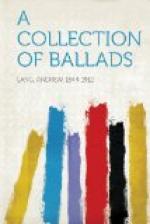Some writers have decided, among them Mr. Courthope, that our traditional ballads are degraded popular survivals of literary poetry. The plots and situations of some ballads are, indeed, the same as those of some literary mediaeval romances. But these plots and situations, in Epic and Romance, are themselves the final literary form of marchen, myths and inventions originally popular, and still, in certain cases, extant in popular form among races which have not yet evolved, or borrowed, the ampler and more polished and complex genres of literature. Thus, when a literary romance and a ballad have the same theme, the ballad may be a popular degradation of the romance; or, it may be the original popular shape of it, still surviving in tradition. A well-known case in prose, is that of the French fairy tales.
Perrault, in 1697, borrowed these from tradition and gave them literary and courtly shape. But Cendrillon or Chaperon Rouge in the mouth of a French peasant, is apt to be the old traditional version, uncontaminated by the refinements of Perrault, despite Perrault’s immense success and circulation. Thus tradition preserves pre-literary forms, even though, on occasion, it may borrow from literature. Peasant poets have been authors of ballads, without being, for all that, professional minstrels. Many such poems survive in our ballad literature.
The material of the ballad may be either romantic or historical. The former class is based on one of the primeval invented situations, one of the elements of the Marchen in prose. Such tales or myths occur in the stories of savages, in the legends of peasants, are interwoven later with the plot in Epic or Romance, and may also inspire ballads. Popular superstitions, the witch, metamorphosis, the returning ghost, the fairy, all of them survivals of the earliest thought, naturally play a great part. The Historical ballad, on the other hand, has a basis of resounding fact, murder, battle, or fire-raising, but the facts, being derived from popular rumour, are immediately corrupted and distorted, sometimes out of all knowledge. Good examples are the ballads on Darnley’s murder and the youth of James vi.
In the romantic class, we may take Tamlane. Here the idea of fairies stealing children is thoroughly popular; they also steal young men as lovers, and again, men may win fairy brides, by clinging to them through all transformations. A classical example is the seizure of Thetis by Peleus, and Child quotes a modern Cretan example. The dipping in milk and water, I may add, has precedent in ancient Egypt (in The Two Brothers), and in modern Senegambia. The fairy tax, tithe, or teind, paid to Hell, is illustrated by old trials for witchcraft, in Scotland. {1} Now, in literary forms and romance, as in Ogier le Danois, persons are carried away by the Fairy King or Queen. But here the literary romance borrows from popular superstition; the ballad has no need to borrow a familiar fact from literary romance. On the whole subject the curious may consult “The Secret Commonwealth of Elves, Fauns, and Fairies,” by the Reverend Robert Kirk of Aberfoyle, himself, according to tradition, a victim of the fairies.




